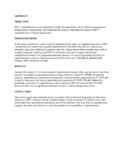| dc.description.abstract | OBJECTIVE
HIV-1 superinfection occurs frequently in high-risk populations, but its clinical consequences remain poorly characterized. We undertook this study to determine the impact of HIV-1 superinfection on disease progression.
DESIGN/METHODS
In the largest prospective cohort study of superinfection to date, we compared measures of HIV-1 progression in women who acquired superinfection with those who did not. Clinical and laboratory data were collected at quarterly intervals. Linear mixed effects models were used to compare postacute viral load and CD4 T-cell counts over time in singly infected and superinfected women. Cox proportional hazards analysis was used to determine the effect of superinfection on time to clinical progression [CD4 cell count <200 cells/μl, antiretroviral therapy (ART) initiation or death].
RESULTS
Among 144 women, 21 of whom acquired superinfection during follow-up, the rate of viral load increase was higher in superinfected than in singly infected women (P = 0.0008). In adjusted analysis, superinfected women had lower baseline viral load before superinfection (P = 0.05) and a trend for increased viral load at superinfection acquisition (P = 0.09). We also observed a borderline association of superinfection with accelerated CD4 cell count decline (P = 0.06). However, there was no significant difference in time to clinical progression events.
CONCLUSION
These data suggest that superinfection is associated with accelerated progression in laboratory measures of HIV-1 disease, but has a limited impact on the occurrence of clinical events. Our observation that superinfected individuals have lower baseline viral load prior to superinfection suggests that there may be host or viral determinants of susceptibility to superinfection. | en_US |

